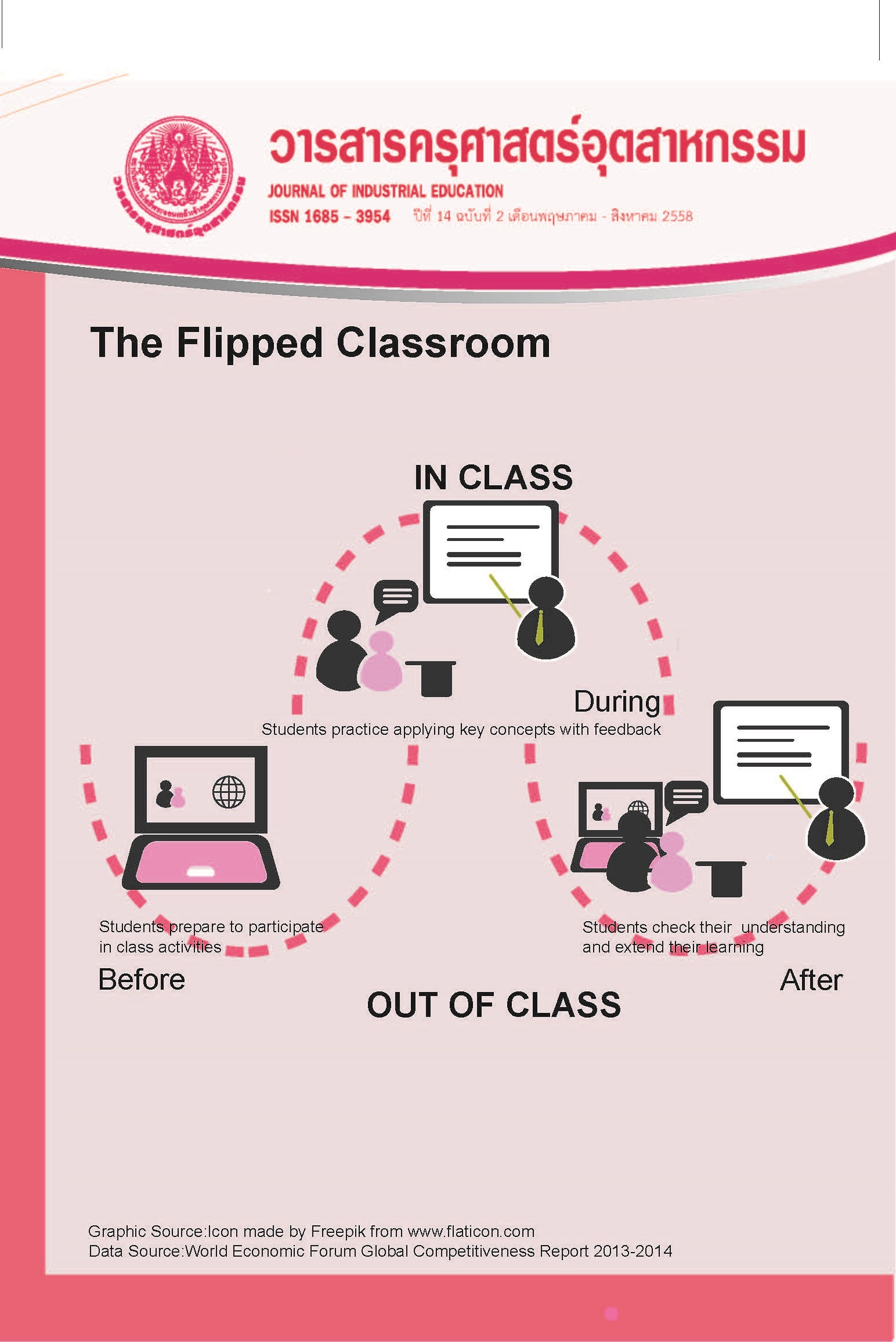บทเรียนบนเครือข่ายอินเทอร์เน็ตเพื่อการทบทวน เรื่อง tenses สำหรับนักศึกษาระดับปริญญาตรี มหาวิทยาลัยเกษมบัณฑิต
Main Article Content
บทคัดย่อ
การวิจัยนี้มีวัตถุประสงค์เพื่อ 1) พัฒนาบทเรียนบนเครือข่ายอินเทอร์เน็ตเพื่อการทบทวนเรื่อง tenses ที่มีคุณภาพและประสิทธิภาพ และ 2) เปรียบเทียบผลสัมฤทธิ์ทางการเรียนของนักศึกษาก่อนเรียนกับหลังเรียนด้วยบทเรียนบนเครือข่ายอินเทอร์เน็ตเพื่อการทบทวนเรื่อง tenses กลุ่มตัวอย่างคือนักศึกษาชั้นปีที่ 1 มหาวิทยาลัยเกษมบัณฑิต จำนวน 60 คน ได้จากการสุ่มแบบแบ่งกลุ่มมาจำนวน 2 กลุ่ม โดยแบ่งเป็นกลุ่มสำหรับหาประสิทธิภาพของบทเรียน จำนวน 30 คน และกลุ่มเปรียบเทียบผลสัมฤทธิ์ทางการเรียน จำนวน 30 คน เครื่องมือที่ใช้ในการวิจัยนี้ประกอบด้วยบทเรียนบนเครือข่ายอินเทอร์เน็ตเพื่อการทบทวนเรื่อง tenses แบบประเมินคุณภาพบทเรียน และแบบทดสอบวัดผลสัมฤทธิ์ทางการเรียน มีค่าความยากง่ายอยู่ระหว่าง 0.20-0.77 ค่าอำนาจจำแนกอยู่ระหว่าง 0.38-0.71 และมีค่าความเชื่อมั่นเท่ากับ 0.89 วิเคราะห์ข้อมูลโดยใช้สถิติค่าเฉลี่ยส่วนเบี่ยงเบนมาตรฐาน การหาประสิทธิภาพของบทเรียน (E1/E2) และการทดสอบทีชนิดสองกลุ่มไม่เป็นอิสระต่อกัน (t-test for dependent samples) ผลการวิจัยพบว่า 1) การพัฒนาบทเรียนบนเครือข่ายอินเทอร์เน็ตเพื่อการทบทวนเรื่อง tenses มีคุณภาพด้านเนื้อหาอยู่ในระดับดี ( = 4.19) มีคุณภาพด้านรูปแบบสื่อประสมอยู่ในระดับดี (
= 4.25) และมีค่าประสิทธิภาพ E1/E2 เท่ากับ 86.92/88.50 และ 2) ผลสัมฤทธิ์ทางการเรียนของนักศึกษาหลังเรียนด้วยบทเรียนบนเครือข่ายอินเทอร์เน็ตเพื่อการทบทวนเรื่อง tenses สูงกว่าก่อนเรียน อย่างมีนัยสำคัญทางสถิติที่ระดับ .05
Article Details
"ข้อคิดเห็น เนื้อหา รวมทั้งการใช้ภาษาในบทความถือเป็นความรับผิดชอบของผู้เขียน"
References
[2] สมเกียรติ อ่อนวิมล. 2011. ภาษาอังกฤษกับอนาคตของไทยในอาเซียน.[Online]. Available : https://blog.eduzones.com/wigi/81880
[3] อรุณี วิริยะจิตรา และคณะ. 2555. เหลียวหลังแลหน้าการสอนภาษาอังกฤษ.กรุงเทพฯ : สู่โลกกว้างจำกัด.
[4] จักรภัทร ดำริธรรมภรณ์ ให้สัมภาษณ์, 11 พฤศจิกายน 2556. สุรวัฒน์ ฐานสโร ผู้สัมภาษณ์. ผลการเรียนรายวิชาภาษาอังกฤษ ในหมวดวิชาศึกษาทั่วไป ของนักศึกษาชั้นปีที่ 1 มหาวิทยาลัยเกษมบัณฑิต. มหาวิทยาลัยเกษมบัณฑิต.
[5] ขนิษฐกัญญา วินิจฉัยกุล, อรุณี วินิจฉัยกุล และวันเพ็ญ ชัยกิจมงคล. 2545. รายงานการวิจัยโครงการศึกษาแนวทางการจัดการเรียนการสอนภาษาอังกฤษในหมวดวิชาศึกษาทั่วไปในมหาวิทยาลัยเชียงใหม่. คณะมนุษยศาสตร์ มหาวิทยาลัยเชียงใหม่.
[6] สุรเชษฐ์ เวชชพิทักษ์ และคณะ. 2546. การพัฒนาสื่อคอมพิวเตอร์ช่วยสอนและเว็บไซต์เพื่อการเรียนรู้ที่มีคุณภาพ.กรุงเทพฯ : กรมวิชาการ กระทรวงศึกษาธิการ.
[7] ไพโรจน์ ตีรณธนากุล, ไพบูลย์ เกียรติโกมล และเสกสรร แย้มพินิจ. 2546. การออกแบบและการผลิตบทเรียนคอมพิวเตอร์การสอนสำหรับ e-Learning. กรุงเทพฯ : ศูนย์ส่งเสริมกรุงเทพ.
[8] Bloom Benjamin S, Editor. 1972. Taxonomy of Educational Objectives Book 1 Cognitive Domain. New York : David McKay Company, INC.
[9] เอกชัย ศิริเลิศพรรณา ทนงศักดิ์ โสวจัสสตากุลและปริยาภรณ์ ตั้งคุณานันต์. 2556. การพัฒนาบทเรียนผ่านเครือข่ายอินเทอร์เน็ต เพื่อทบทวนเรื่อง การเคลื่อนที่แบบโมชั่นทวีน วารสารครุศาสตร์อุตสาหกรรม, 12(3), น.43.
[10] ปรียา นาคเงินทอง. 2553. บทเรียนบนเครือข่าย อินเทอร์เน็ตเรื่องการอ่านและเขียนสูตรสารประกอบไฮโดรคาร์บอนและอนุพันธ์ของโฮโดรคาร์บอน. วิทยานิพนธ์ครุศาสตรอุตสาหกรรมมหาบัณฑิต สาขาเทคโนโลยีการศึกษาทางการอาชีวศึกษาและเทคนิคศึกษา. บัณฑิตวิทยาลัย สถาบันเทคโนโลยีพระจอมเกล้าเจ้าคุณทหารลาดกระบัง.
[11] กฤษณา สิกขมาน. 2554. รายงานการวิจัยเพื่อพัฒนาการเรียนการสอน เรื่อง การศึกษาผลสัมฤทธิ์ทางการเรียนรายวิชาการสื่อสารภาษาอังกฤษธุรกิจ โดยการใช้การสอนแบบ E-Learning กรุงเทพฯ: มหาวิทยาลัยศรีปทุม.

